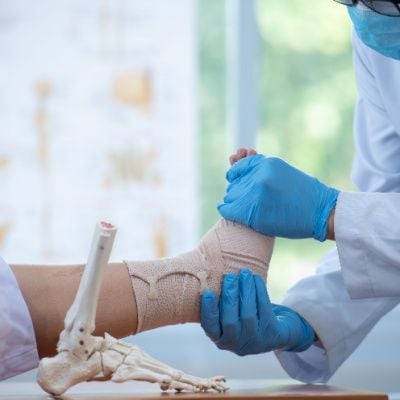 Ankle surgery, though a significant medical intervention, is often necessary to restore mobility, alleviate pain, and improve the overall quality of life for individuals facing debilitating ankle conditions. In this comprehensive guide, we embark on a journey to demystify ankle surgery – exploring the diverse procedures available, delving into the nuances of preoperative preparation, understanding the intricacies of recovery, and managing postoperative expectations. Let's unravel the complexities of ankle surgery, providing valuable insights for those considering or undergoing this transformative medical journey.
Ankle surgery, though a significant medical intervention, is often necessary to restore mobility, alleviate pain, and improve the overall quality of life for individuals facing debilitating ankle conditions. In this comprehensive guide, we embark on a journey to demystify ankle surgery – exploring the diverse procedures available, delving into the nuances of preoperative preparation, understanding the intricacies of recovery, and managing postoperative expectations. Let's unravel the complexities of ankle surgery, providing valuable insights for those considering or undergoing this transformative medical journey.
Understanding the Need for Ankle Surgery
Chronic Ankle Pain and Functional Impairment
Ankle surgery becomes a consideration when chronic pain and functional impairment significantly impact an individual's daily life. Conditions such as severe ankle arthritis, ligament injuries, or structural abnormalities may necessitate surgical intervention to address underlying issues and enhance overall ankle function.
Common Conditions Requiring Ankle Surgery
Ankle Arthritis: Degenerative Joint Disease
Ankle arthritis, characterized by the progressive deterioration of the ankle joint's cartilage, can result in debilitating pain and stiffness. When conservative measures like medications and physical therapy no longer provide relief, surgical options such as ankle fusion or ankle replacement may be considered.
Ligament Injuries: Instability and Reconstruction
Severe ligament injuries, often a consequence of trauma or repetitive stress, may lead to ankle instability. Surgical reconstruction of damaged ligaments, using techniques like ankle ligament repair or reconstruction, aims to restore stability and prevent recurrent sprains.
Tendon Disorders: Repair and Reconstruction
Tendon disorders, including Achilles tendon rupture or chronic tendinitis, may require surgical intervention. Procedures such as tendon repair or reconstruction aim to restore normal tendon function and alleviate pain, facilitating a return to regular activities.
Preoperative Evaluation and Planning
Comprehensive Medical Assessment
Before undergoing ankle surgery, individuals undergo a comprehensive medical assessment. This evaluation includes a thorough review of medical history, imaging studies (such as X-rays or MRIs), and a discussion of the individual's symptoms and functional limitations.
Consultation with a Foot and Ankle Specialist
A crucial step in the preoperative phase is consultation with a foot and ankle specialist. This specialist collaborates with the individual to discuss treatment options, assess the benefits and risks of surgery, and develop a personalized surgical plan tailored to the specific condition and goals.
Informed Decision-Making
Informed decision-making is a cornerstone of the preoperative process. Individuals considering ankle surgery are provided with detailed information about the procedure, potential risks, expected outcomes, and the rehabilitation process. This empowers individuals to participate in their healthcare decisions actively.
Types of Ankle Surgery Procedures
Ankle Arthroscopy: Minimally Invasive Exploration
Ankle arthroscopy is a minimally invasive procedure that involves inserting a tiny camera and specialized instruments through small incisions to visualize and address issues within the ankle joint. This technique is often employed for diagnostic purposes and the treatment of conditions like synovitis or loose bodies.
Ankle Fusion (Arthrodesis): Stabilizing the Joint
Ankle fusion involves surgically stabilizing the ankle joint by fusing the bones together. This procedure is commonly recommended for individuals with advanced ankle arthritis, providing pain relief by eliminating joint motion. While it restricts joint movement, ankle fusion can effectively alleviate pain and improve function.
Total Ankle Replacement: Restoring Joint Function
Total ankle replacement, also known as ankle arthroplasty, is a procedure designed to replace the damaged ankle joint with an artificial implant. This surgical option aims to preserve joint movement while alleviating pain and improving overall ankle function. Total ankle replacement is often considered in cases of advanced arthritis.
Ankle Ligament Repair or Reconstruction: Restoring Stability
Ankle ligament repair or reconstruction involves addressing damaged ligaments to restore ankle stability. This may be recommended for individuals with chronic ankle instability due to ligament injuries. Various surgical techniques, including using autografts or allografts, can be employed to reconstruct the damaged ligaments.
Achilles Tendon Repair or Reconstruction: Restoring Function
Achilles tendon repair or reconstruction is performed to address conditions such as Achilles tendon rupture or chronic tendinopathy. This surgical intervention aims to restore the continuity and function of the Achilles tendon, facilitating improved strength and function of the ankle.
Anesthesia and the Surgical Process
Anesthesia Options
Ankle surgery is typically performed under regional or general anesthesia. Regional anesthesia, such as a nerve block, numbs the lower extremity, allowing the individual to remain awake during the procedure. General anesthesia induces a state of unconsciousness, ensuring the individual feels no pain or discomfort.
The Surgical Process
The specific steps of ankle surgery depend on the procedure being performed. In arthroscopic procedures, small incisions are made to introduce the camera and instruments. For more extensive surgeries like ankle fusion or replacement, larger incisions are required to access and address the affected structures. Surgeons meticulously follow the surgical plan developed during the preoperative phase.
Duration of Surgery
The duration of ankle surgery varies based on the complexity of the procedure. While arthroscopic procedures may take an hour or less, ankle fusion, total ankle replacement, or extensive ligament reconstructions may require several hours in the operating room.
Recovery and Rehabilitation
Immediate Postoperative Care
After ankle surgery, individuals are closely monitored in the recovery area. Pain management, wound care, and early mobility exercises are initiated to prevent complications and support the healing process. In some cases, individuals may need to use crutches or a brace to assist with initial mobility.
Hospital Stay and Ambulatory Surgery
The length of hospital stay following ankle surgery varies. Some procedures, particularly arthroscopic surgeries, may be performed on an ambulatory basis, allowing individuals to return home on the same day. More extensive surgeries like ankle fusion or replacement may require a hospital stay for observation and initial recovery.
Physical Therapy and Rehabilitation
Physical therapy is a fundamental component of the recovery process. Physical therapists guide individuals through exercises to improve strength, flexibility, and joint mobility. Rehabilitation plans are tailored to the specific surgical procedure and the individual's unique needs.
Managing Postoperative Expectations
Gradual Improvement
Managing postoperative expectations is crucial for individuals undergoing ankle surgery. While immediate relief from pain and improved function are common goals, the full benefits of surgery may take time to manifest. Gradual improvement and rehabilitation milestones contribute to long-term success.
Temporary Discomfort and Swelling
It's common to experience temporary discomfort, swelling, and bruising after ankle surgery. These postoperative symptoms are typically managed with pain medications, elevation, and adherence to the prescribed rehabilitation plan.
Return to Activities and Long-Term Outcomes
The timeline for returning to regular activities varies based on the specific procedure and individual factors. Full recovery may take weeks to months, and the ability to resume specific activities depends on factors such as the nature of the surgery, rehabilitation progress, and the overall health of the individual.
Potential Complications and Risks
Infection and Wound Healing Issues
While rare, infection and wound healing issues are potential complications of ankle surgery. Strict adherence to postoperative care instructions, including keeping the incision site clean and dry, helps minimize the risk of infection.
Nerve or Vascular Injury
In some cases, there may be a risk of nerve or vascular injury during ankle surgery. Surgeons employ meticulous techniques and utilize advanced imaging to minimize these risks. Any persistent or new-onset neurological symptoms should be promptly reported to the healthcare team.
Implant-related Complications
For procedures involving implants, such as total ankle replacement, there is a risk of implant-related complications. This may include issues like implant loosening or wear over time. Regular follow-up appointments and monitoring help detect and address potential complications early.
Seeking Professional Guidance and Second Opinions
Open Communication with Healthcare Providers
Open communication with healthcare providers is essential throughout the ankle surgery journey. Individuals are encouraged to discuss any concerns, questions, or unexpected symptoms with their surgical team. Clear communication fosters a collaborative approach to care.
Seeking Second Opinions
For individuals considering ankle surgery, seeking a second opinion can provide valuable insights and ensure a well-informed decision. Consulting with another experienced foot and ankle specialist can offer alternative perspectives on treatment options and enhance confidence in the chosen course of action.
Conclusion
In conclusion, ankle surgery represents a transformative step toward reclaiming mobility, alleviating pain, and enhancing overall ankle function. By demystifying the procedures, intricacies of recovery, and postoperative expectations, individuals can approach ankle surgery with informed confidence. Whether addressing chronic arthritis, ligament injuries, or tendon disorders, the collaboration between individuals and their healthcare providers is paramount for a successful surgical journey. This comprehensive guide aims to empower individuals facing ankle surgery, offering a roadmap to navigate the complexities and embrace a future of improved ankle health.
Disclaimer:
The information on this website is provided for educational and information purposes only and is not medical advice. Always consult with a licensed medical provider and follow their recommendations regardless of what you read on this website. If you think you are having a medical emergency, dial 911 or go to the nearest emergency room. Links to other third-party websites are provided for your convenience only. If you decide to access any of the third-party websites, you do so entirely at your own risk and subject to the terms of use for those websites. Neither Family Foot & Ankle Care, PC, nor any contributor to this website, makes any representation, express or implied, regarding the information provided on this website or any information you may access on a third-party website using a link. Use of this website does not establish a doctor-patient relationship. If you would like to request an appointment with a health care provider, please call our office at 480-732-0033.















